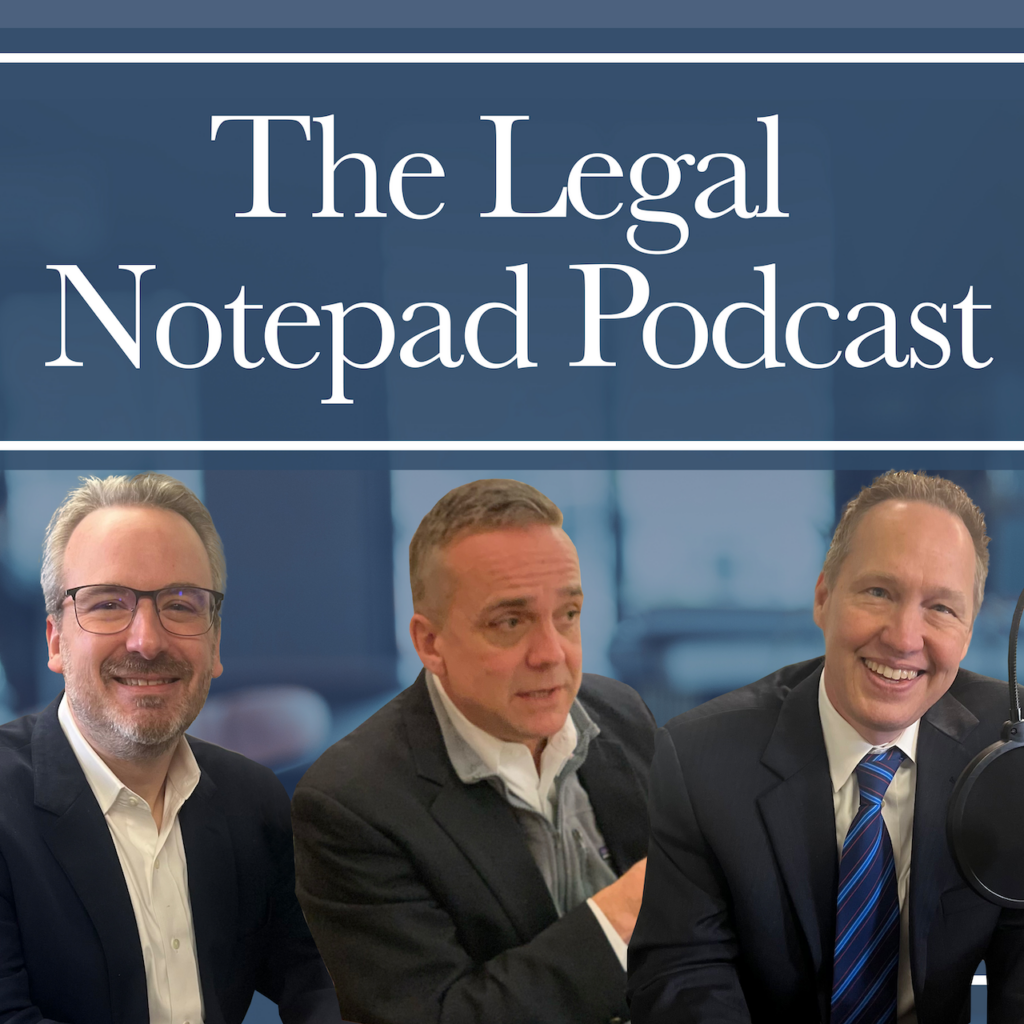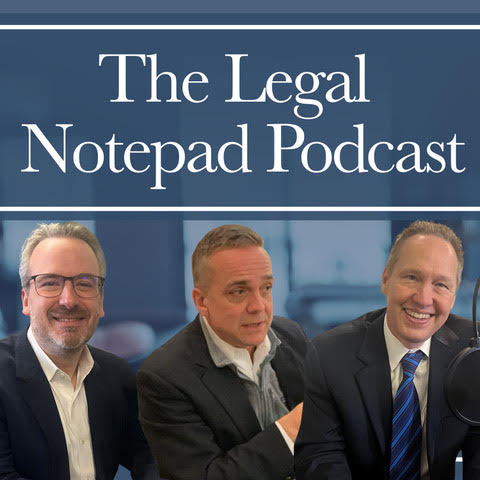Episode 6: Louisville attorneys Rob Mattingly and Kevin C. Burke explain the rules regarding the process for using summaries at trial, in Kentucky. These can be extremely useful, but you have to follow the process to get them admitted. They’re joined by Rob’s paralegal, Lauren Hincks.
Editor’s Note: If you are an attorney and would like CLE credit for this episode, visit the Kentucky Justice Association website, click the Education and Training tab and look for the podcast.

TODAY’S LEGAL QUESTION:
What is the proper process for admitting some of my summaries, while excluding some of the defense’s summaries?
Rob begins by reading KRE 1006, which specifically dealing with summaries.
Kevin likes how well the rule lays out the process. It’s a useful tool for trial. He points out the verbiage, “…the contents of voluminous writings, recordings or photographs…” So, there has to be a lot of them that can’t conveniently be presented in court. The rule goes on to state, “[They] may be presented in the form of a chart, summary or calculation.” This gives the attorney some latitude.
The rule requires timely notice be filed with the court regarding the intention to use a summary. The originals or duplicates will also need to be made available for examination and/or copying.
At the time of this recording, there are 11 cases citing the rule (6 civil, 4 criminal and 1 family law).
Using Summaries for Medical Bills
The 2007 case Walls vs. Robinson is an unpublished opinion from the KY Court of Appeals, involving a motor vehicle accident. The plaintiff read a summary of the medical expenses, and summary was admitted as an exhibit. The defendant objected. It was one of the issues that was appealed.
The court decided it was proper for the plaintiff to have both read and admitted the summary into evidence. Medical bills are an exception to the hearsay rule (KRE 803(6)). The underlying information was not hearsay. You can’t convert inadmissible information into admissible information by using a summary.
The case was reversed, but on a different point. The plaintiff indirectly referenced insurance in the closing argument. Defense objected to a “pot of money” statement. However, the court spoke directly to the issue involving the summary.
Rob comments that another unpublished case, Almon vs. Mary Bullock and Safeco Insurance Company, is useful if you need to argue summaries of medical expenses can be entered. This was another motor vehicle accident case.
Both of the above cases are unpublished. For more information on the proper way to cite unpublished opinions, listen to Episode 5 of The Legal Notepad Podcast.
What if Opposing Counsel Is Attempting to Keep Your Summary Out?
It might be argued that the information is in fact not consider voluminous, therefore the summary doesn’t need to be admitted. Remember, if it’s admitted into evidence, it goes back to the jury room.
Kevin discusses Haeberle vs. McCall (2007), another unpublished opinion from the KY Court of Appeals. This was an employment contract dispute involving a dentist and his employer. The dispute involved a lot of laboratory bills, spanning a 4-year period. It directly impacted Dr. Haeberle’s compensation.
On appeal, the plaintiff (Haeberle) argued the summary should not have been admitted. They argued the amount of bills were not voluminous. Haeberle also argued the best evidence rule. The court dismissed these particular arguments. The defendant met the requirements of the rules.
The court rejected the plaintiff’s argument that the records weren’t voluminous, based on Rule 1006. “Too burdensome to produce” was a made-up standard. The rule states that the information couldn’t conveniently be examined by the court. There were at least 4 years of bills. The summary was allowed.
Rob emphasizes the nature of the word “convenient,” even though the information may not actually be voluminous.
What If You or Opposing Counsel Failed to Give Notice?
There are many reasons an attorney may not want to give notice of a summary (i.e. strategic reasons). However, the rule specifically requires notice to be given.
However, what happens if you forgot or didn’t know 1006 exists? Can you still get the information in?
Kevin refers two cases dealing with this issue. The first is Robinson vs. University of Kentucky Medical Center (2003 unpublished opinion). The second is Whitlow Construction and Development vs. Kentucky Bank.
Both opinions said the summaries could not be used, because the attorney did not comply with Rule 1006. The evidence (i.e. the summaries) must be filed in a timely manner.
Nonetheless, while the summaries are out, you can still get the evidence in through testimony of a witness.
So, What Is Meant by Timely Filing?
Rob often reviews trial orders. There is something related to filing exhibits. Look for the closest thing that might apply. Comply with that deadline.
Rob often includes summaries in his answers to interrogatories. It’s a way to make sure everyone is on notice that the summary is going to be used.
What Is a Summary and What if a Business Record Contains a Summary?
Kevin cites Sparks vs. Commonwealth. It’s a 2003 unpublished opinion from the Kentucky Court of Appeals. This one happens to be a criminal case.
The issue involved bank statements, which are typical examples of a summary within a business record. An attorney argued the statements showed individual deposits and therefore opposing counsel was required to comply with Rule 1006 by providing it as a summary. Therefore, the bank entries should have been excluded.
The defendant was convicted and appealed. The court ruled bank statements are business records. Rule 1006 doesn’t apply. The rule applies to summaries that are created for trial.
Are there other Examples When Information might be a Summary?
Kevin explains that the rule specifically mentions writings, recordings or photographs. It’s pretty broad. For instance, a summary of blood pressure readings would need to comply, such as in the case Dye vs. Western Kentucky University.
Summaries of texts, voicemails and/or emails can be summarized and therefore the rule would apply. Kevin cites Dusing vs. Bakker (2023 KY Court of Appeals unpublished opinion). While these records were deemed to be admissible under Rule 801(A)(b), they qualified as summaries per KRE 1006.
Kevin references Davenport vs. Ephraim McDowell Memorial Hospital (769 S.W.2d 56), a Kentucky Court of Appeals opinion from 1988. This case also addresses summaries. The case involved a summary of a nurse’s testimony during her deposition.
The court held the information qualified as a summary and therefore fell under KRE 1006.
Remember, the Rule doesn’t just apply to medical bills. There are many other types of information that can be made into summaries and therefore required to comply with the rule.
That’s a wrap on today’s discussion. We hope you found the discussion insightful. As always, we encourage you to share this episode with your colleagues.
If you’d like the case notes, please sent us an email request and we’ll be happy to email you the file including the cases, rules, etc.
You can follow our podcast on a variety of platforms including, Spotify, iHeartRadio, Amazon Music, Audible, Apple Podcasts and many more. Thanks for taking the time to listen.
For more information about the Law Offices of DeCamillis and Mattingly, PLLC
Address: 138 S. Third Street, Louisville, KY 40202 (across from The Old Spaghetti Factory)
Phone: (502) 589-2822
Website: DeCamillisMattingly.com
To Contact Kevin Burke:
Website: BurkeNeal.com
Phone: (502) 709-9975
The Kentucky Bar Association Requires Us to State “This is an advertisement.”



